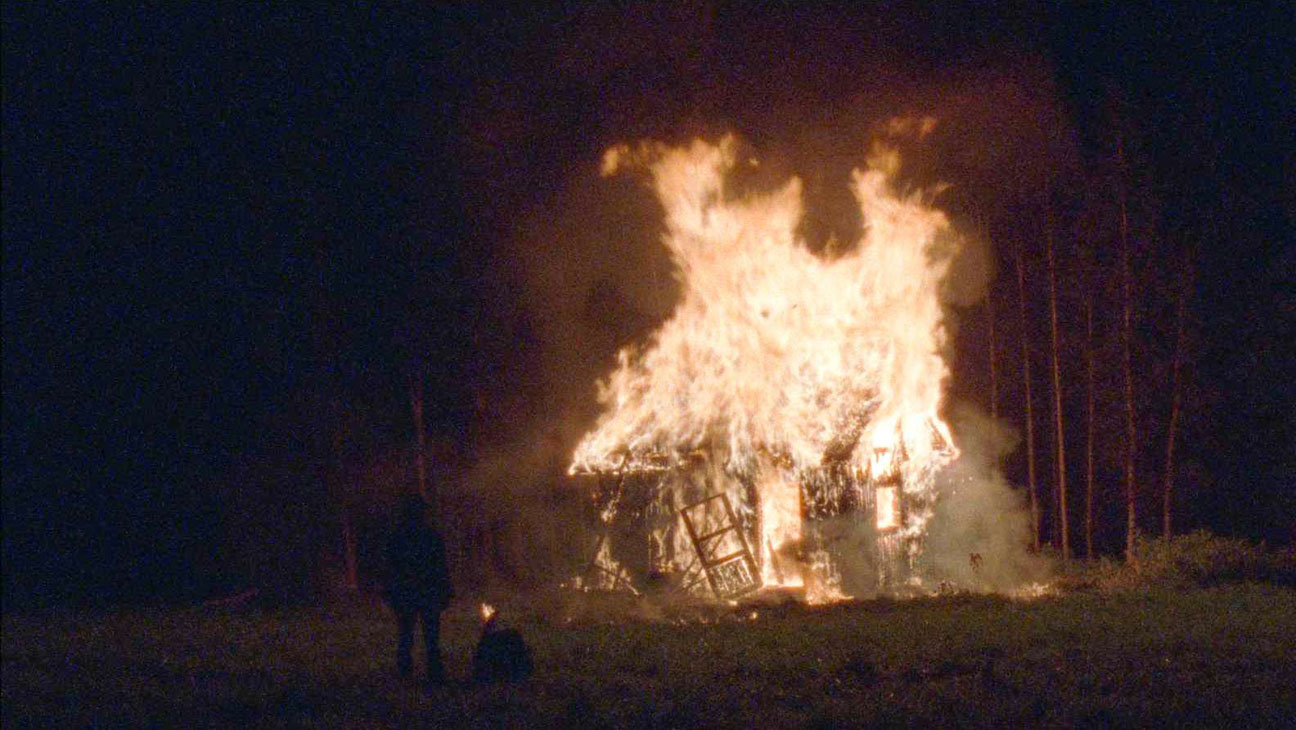
Roughly half way through “A Spell to Ward Off the Darkness (2013)” is a prolonged shot of a man fishing on a lake while a rainstorm gently builds around him. The shot is stable with the only movement provided by the boat as it drifts around in mid frame. Raindrops delicately splash in the foreground and, in the far distance, a bolt of lightning flashes too far away to be heard. The shot stretches out for several minutes, and it’s a testament to the transformative power of the movie, that by this point in the movie, I didn’t want this shot to end. “A Spell to Ward off the Darkness” is in a sense a spiritual travelogue, if not a cinematic vehicle for spiritual pilgrimage, best seen in a temporary commune of the like-minded that occur from time to time in movie houses and at festivals like the Ann Arbor Film Festival.
Why the hell am I reviewing a “spiritual travelogue” on a horror website? Regular readers of The Daily Nightmare know we examine Midwest Snob Horror as these products reveal the glories and travails of the human condition. “A Spell to Ward off the Darkness” is in no way a genre horror movie, despite the title’s intimation of both witchcraft and cosmic darkness, and despite the final scenes where the central figure dons corpse paint to front a black metal band. This is a movie about the durability of hope and the fragility of its specific expressions. But if you are a horror fan you would do well to see this movie. The endless, brain-eating parade of apocalypse-porn movies of recent years has slowly eroded our will to imagine a better life, a better life together, a better life together that may only appear fragmentarily, temporarily, and from time to time. “A Spell to Ward off the Darkness” examines three possible utopias, strung together roughly by a central figure’s pilgrimage. Sort of. An analysis here is appropriate because horror is best portrayed against a backdrop of hope.
The first provisional utopia is a commune somewhere in Eastern Europe. (End credits reveal it to be Estonia.) Time for these dozen or so members is measured in long moments of reflection, music, naps, sauna baths, cigarette smoking, and the construction of a geodesic dome from plans to a completed structure. The courage of the filmmakers is to let shots run until the magic happens. For instance, in one shot a woman leisurely smokes a cigarette on the porch when, about a minute in, a plume of woodsmoke from the shack felicitously wafts into the frame, revealing beams of dappled sunshine that entirely reconfigure the image, creating a cathedral of light that frames her. These long gazes into the oft overlooked moments of life provide an antidote to the manipulative, barrage of short shots quickly edited that assail us in so much commercial culture.
The central figure is a black guitarist who I believe does not speak a single word throughout the film. He smokes a cigarette in the nearly completed dome before embarking on a period of Thoreauvian solitude that forms the second possible utopia. This second section of the film presents some of the most striking images, one of my favorite being a closeup of an ant colony, miked so closely to detect their thrumming activity. But my double-plus good favorite shot of the entire film lingers on the fire that consumes the central character’s shack at the end of this section. I just LOVE watching shit burn down, something I first realized watching Tarkovsky’s The Sacrifice. Maybe I should talk to a therapist about that predilection.
The final segment of the film focuses on the central figure as he fronts a black metal band. The camerawork is sinuous — in contrast to the sometimes jerky hand-held footage of the commune sequence — gliding amid the musicians, as the singer wails both plaintive and feral and the guitars and drum pound, complex and intense. The corpse paint on the performers liquefies with their sweat during the performance. Only in this final section are there faces of older people, scattered in the audience. As a middle aged guy myself, I was left wondering if the yearning for hope, for community is a young person’s dream. The central figure does not rest at this utopia either but wipes off his makeup to head out into the darkness, perhaps toward an enigmatically pulsing light.
The key insight I took from the movie was the allusion, made rather early on, to the notion of a temporary autonomous zone, that moment of free-play and synchronicity that sometimes occurs at a good party, or a good rave. Individual utopias emerge and pass away, but that yearning for a better way of life is an enduring ground of human hope.
I can hear the gore-hounds grumbling already. Sure, “A Spell to Ward off the Darkness” could be dismissed as experimental but it’s a successful experiment. In absolutely no way could it be called a thriller, though the sense of wonder and tenuous encouragement it kindles is, I suppose, a kind of thrill. Do not be deceived; it is NOT a horror movie in any sense but for cry it out loud, take a break from watching yet another re-made slasher film or still-born undead re-hash, could ya? See “A Spell to Ward off the Darkness” preferably in the presence of others with open hearts and open minds. If you absolutely have to counter-act its message with a bit of gloom, maybe make a double feature of the evening and watch “Until the Light Takes Us” about the grimmer side of first generation Norwegian black metal.
